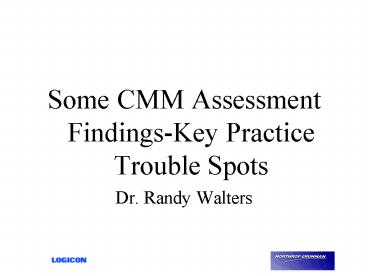Some CMM Assessment FindingsKey Practice Trouble Spots - PowerPoint PPT Presentation
1 / 20
Title:
Some CMM Assessment FindingsKey Practice Trouble Spots
Description:
... 1, AC-2, ISM AC-1 Develop/maintain/document/tailor organization standard process ... Tailoring project processes from the organizational process ... – PowerPoint PPT presentation
Number of Views:42
Avg rating:3.0/5.0
Title: Some CMM Assessment FindingsKey Practice Trouble Spots
1
- Some CMM Assessment Findings-Key Practice Trouble
Spots - Dr. Randy Walters
2
Key Process Areas (KPAs)
Continuously improving and business innovation
Quantitative management control focus
Process definition Integrated end-to-end process
architecture
Process discipline Basic management control
Ad hoc, chaotic
3
State of Practice (SEI-December 1998)
55.2
697 Organizations since 1993
25.8
15.6
2.7
0.6
2 Repeatable
3 Defined
4 Managed
5 Optimizing
1 Initial
4
Key Process Area Structure
- Goals supported by Key Practices (KPs)
- KPs
- State the fundamental policies, procedures, and
activities for a KPA - Describe what is to be done,
- Do not interpret them as a mandate for how
- CMM has 316 key practices
- 121 at Level 2
- 108 at Level 3
5
Key Process Area Structure
- KPs organized by Common Features
- Commitment to perform (CO-n)
- Org. policies for proj, Sr. mgt leadership
- Ability to perform (AB-n)
- Groups for, adequate resources, training for
roles - Activities performed (AC-n)
- Measurement and analysis (ME-n)
- Measurements made and used for...
- Verifying implementation (VE-n)
- SQA reviews/audits, sr. mgt review, compliance
6
Background
- Assessments- SPAs, CBA-IPI, CMM-based evaluation
(Consortium developed) - Data analyzed from 1991-1997 assessments done by
Software Productivity Consortium - 104 Assessments
- 2,221 analyzed findings
- 1,651 mapped to CMM Key Practices
- 270 duplicates and excluded findings
- 300 positive, general or neutral findings
- Military, aerospace, communications, business
7
Distribution of Weaknesses Found in Level 2 KPAs
8
Weakness Percentage () in Level 2 KPAs
Number of assessments finding weakness in
KPA / Number of times KPA assessed
9
Top Pitfall Practices in Level 2 KPAs
Number of assessments finding weakness in
Key Practice (KP) / Number of times KPA assessed
10
Top Pitfall Practicesin Level 2 KPAs
11
Distribution of Weaknesses Found in Level 3 KPAs
12
Weakness Percentage () in Level 3 KPAs
Number of assessments finding weakness in
KPA / Number of times KPA assessed
13
Top Pitfall Practices in Level 3 KPAs
Number of assessments finding weakness in
Key Practice (KP) / Number of times KPA assessed
14
Top Pitfall Practicesin Level 3 KPAs
15
Common Themes
- Following documented procedures
- SPP AC-9, AC-10, AC-12 Size/Effort/Cost
procedures - OPD AC-1, AC-2, ISM AC-1 Develop/maintain/document
/tailor organization standard process - ISM AC-4 Manage according to defined process
16
Common Themes
- Deriving and tracking estimates
- SPP AC-9, AC-10, AC-12 Estimation procedures
- SPTO AC-5, AC-6, AC-7, AC-8 Tracking of
size/effort/cost/schedule/critical resources - Demonstrating commitment by management
- SPP CO-2, SQA CO-1 Project and SQA Policy
- All level 3 CO-1 Policies
- Providing training
17
Common Themes
- Providing training
- SQA AB-4, SCM AB-5(SCM training)
- TP CO-1( Training Program Policy),
- TP AC-1, AC-2 Training plans and courses
18
Assessor Experiences
- Level 2 KPs most often missed
- Estimating work product sizes according to a
documented procedure - Estimating effort and cost according to a
documented procedure - Tracking work product sizes
19
Assessor Experiences
- Level 3 KPs most often missed
- Developing an organizational training plan
according to a documented procedure - Tailoring project processes from the
organizational process - Developing the organizational process according
to a documented procedure
20
Assessor Experiences
- General pitfalls
- Visibility and communication of decisions,
changes, results of negotiations among all groups - Detailed and effective risk management
- Definitions and interpretations of
- Organization, project, roles, groups, members
- Who constitutes senior management
- Software Configuration Control Board
- Customer(s)
- Execution evidence and process assets retained






























